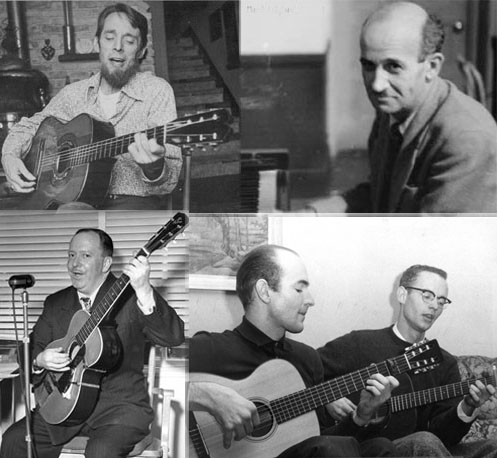
Clockwise from upper left: Walt Robertson,
Paul Ashford, Bob Nelson, Don Firth, Ivar Haglund.
SEATTLE FOLKSINGERS
THOSE WHO LED THE WAY
By Bob Nelson
Washington State has a rich legacy of folksingers. I first became aware these singers and their songs when I was ten years old and met Ivar Haglund. My parents often to took me to his waterfront aquarium located at pier 54 in downtown Seattle. He had a small building, built on the wharf over the water. He started his business on a shoestring and it showed. He used to sit on a stool, just inside the entry door, and collect ten cents from visitors as they entered. Inside, you were greeted by about a dozen saltwater aquariums and the entire room smelled like low tide at the beach. These aquariums contained many of the fish and aquatic plant life that were common to Puget Sound. But for me, the real highlight was when, occasionally, Ivar would take his guitar in hand and entertain the visitors with his folksongs. He was a fine singer with a rich and melodic voice. This all happened in the late 1940’s.
By the early 1950’s, Ivar had a weekly radio show titled “Keep Washington Green” (KCTS-TV, Jan. 20, 1959: Jim Stevens & Ivar Haglund are introduced and talk about songs from the Keep Washington Green Campaign). It was sponsored by Washington State and was one of the first efforts to raise public awareness of the dangers of forest fires. His frequent guest was Jim Stevens, the composer of The Ballad of the Frozen Logger (KCTS-TV, Jan. 20, 1959: Jim Stevens talks about his books and songs, and Don Firth sings The Frozen Logger). Jim grew up in the logging camps of the northwest where he learned a wealth of traditional northwest logging ballads and stories. Some of these bunkhouse tales resulted in The Tales of Paul Bunyan. Ivar’s weekly radio show quickly became an event that I rarely missed. Ivar also welcomed Woody Guthrie and Burl Ives and Pete Seeger to his Bainbridge Island home.
John Ashford (John Ashford sings Little Old Cabin On My Claim) tells stories from his childhood that go back to the early days of WW2 when Pete Seeger was stationed at Fort Lawton. On occasional Sundays, Pete would come to the home of John Ashford’s father, folksong collector Paul Ashford (The Paul Ashford Archive). It was there that they would gather around the family piano and bring out the guitars and banjos and recorders and enjoy sharing their songs.
In 1949 I met Bill Higley. He had recently married a family friend and they had moved from Anchorage to Seattle. In Anchorage he was a radio personality with a popular daily show, using the radio name of “Willi Waw Willy”. His shows were a mixture of his cornball humor and folk songs from his large repertoire. Before the Second World War he shared a radio mike in San Francisco with Harry K. McClintock, aka Haywire Mac. Bill Higley quickly became my musical mentor and started me on my path of folksinging.
In 1953 I met Don Firth and the late Walt Robertson. Both of these men became lifelong friends and continued my musical education as well as fostering my lifelong interest in the collecting and performing of our traditional folk music. In the next issue I will talk about Walt Robertson, and in the following issue, Don Firth. This is the beginning of a series of articles on Seattle Folksingers: Those Who Led The Way.
THOSE WHO LED THE WAY
WALT ROBERTSON
THOSE WHO LED THE WAY
DON FIRTH
THOSE WHO LED THE WAY
JOHN DWYER
THOSE WHO LED THE WAY
JOHN ASHFORD & SALLY PUSHKARA ASHFORD